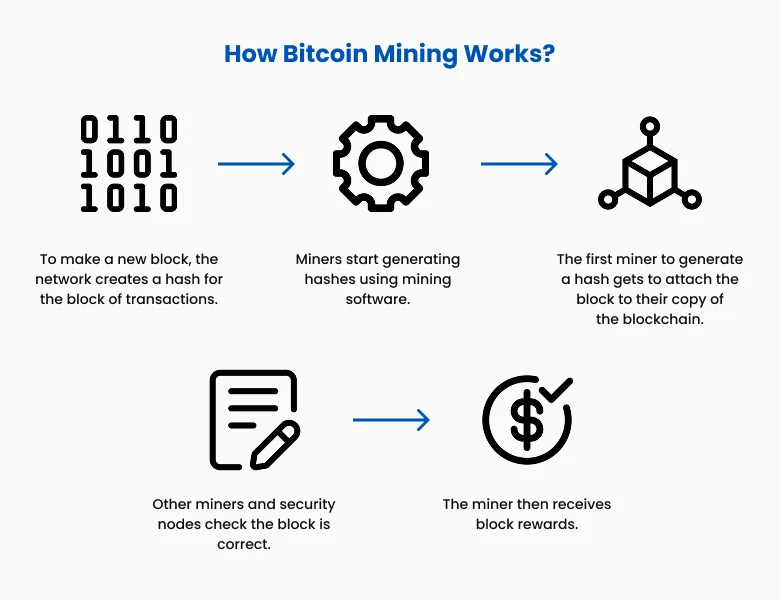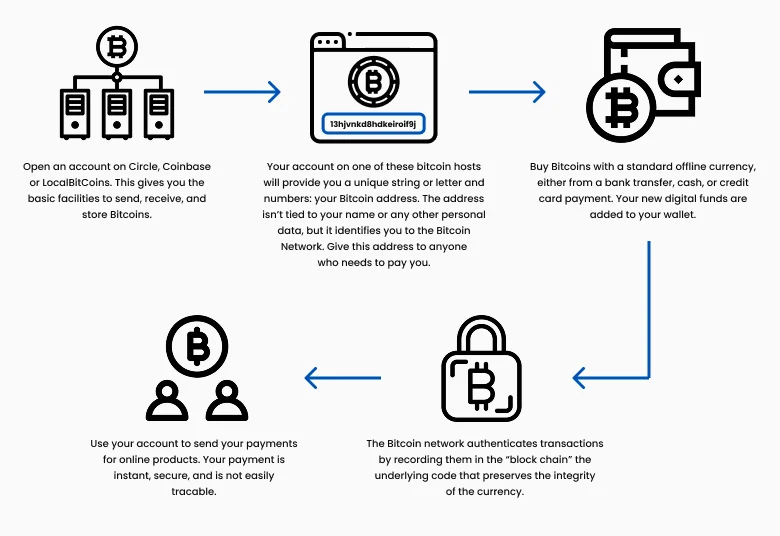

What Is Bitcoin (BTC)? How It Operates, How to Purchase and Mine It
Bitcoin (BTC) is a cryptocurrency (a digital currency) designed to function as money and a payment method independent of any individual, group, or institution. This eliminates the need for trusted intermediaries (e.g., a mint or bank) in financial transactions. Bitcoin was introduced to the public in 2008 by an anonymous creator known as Satoshi Nakamoto and has since developed into the world’s most recognized cryptocurrency. Beyond its role as a digital currency, Bitcoin has become a highly liquid asset across global markets. Its price volatility attracts active traders who employ various strategies such as day trading and swing trading to capitalise on short-term price movements. Traders frequently use popular technical indicators like RSI, MACD, or Fibonacci retracement levels to determine optimal entry and exit points. As the market evolves, Bitcoin remains central to crypto trading activity—providing opportunities for both speculative trades and long-term investment strategies via sophisticated CFD trading platforms.
Key Takeaways
Bitcoin is the culmination of contributions from many individuals, but it is widely recognized that Satoshi Nakamoto created and introduced it in 2008.
Bitcoin is the public blockchain protocol used to create and manage the cryptocurrency of the same name.
Bitcoin mining is the competitive process where miners hash block data, solve a cryptographic puzzle, and add a new block to the blockchain. The miner who successfully solves the puzzle receives a bitcoin reward.
Bitcoin can be utilized by speculators, investors, and consumers for transactions or as a store of value.
Investing in and using bitcoins involves various risks, including price volatility, fraud, and theft.
What Is Bitcoin (BTC) and How Does It Work?
Figure 1: Bitcoin mining and the decentralized architecture of the Bitcoin network
What Is a Bitcoin (BTC)?
The domain Bitcoin.org was registered in August 2008. It was created by Satoshi Nakamoto and Martti Malmi, who collaborated with the anonymous Nakamoto to develop Bitcoin.
How and When Did Bitcoin (BTC) Start?
In October 2008, Nakamoto announced on the cryptography mailing list at metzdowd.com: "I've been working on a new electronic cash system that's fully peer-to-peer, with no trusted third party." The now-iconic white paper published on Bitcoin.org, titled "Bitcoin: A Peer-to-Peer Electronic Cash System," became the foundational document for Bitcoin’s operation today.
Bitcoin Genesis Block
The first Bitcoin block was mined on January 3, 2009. Block 0, known as the genesis block, contains the message "The Times 03/Jan/2009 Chancellor on brink of second bailout for banks," serving as evidence that the block was mined on or after that date.
Bitcoin Mining Rewards Over Time
Bitcoin mining rewards halve every 210,000 blocks. Initially, the block reward was 50 bitcoins in 2009. On May 11, 2020, the third halving reduced the reward to 6.25 bitcoins per block. The fourth halving occurred in April 2024, lowering the reward to 3.125 bitcoins. The next halving is expected around mid-2028, reducing the reward to 1.5625 BTC.
Bitcoin Units and Denominations
One Bitcoin (BTC) is divisible to eight decimal places (one hundred millionth of a bitcoin), with the smallest unit called a satoshi.
The Cryptography Mailing List announced the initial release of Bitcoin software on January 8, 2009. On January 9, 2009, Block 1 was mined, marking the start of Bitcoin mining.
Bitcoin (BTC) and Blockchain Technology Explained

Figure 2: How blockchain technology functions
Bitcoin as a digital currency is straightforward to understand. For example, owning Bitcoin allows you to use a cryptocurrency wallet to send fractions of a bitcoin as payment for goods or services. However, the underlying mechanics of Bitcoin are complex.
Bitcoin (BTC) Blockchain Explained
A blockchain is a distributed ledger—a shared database secured by cryptographic methods. "Distributed" means it is stored across multiple computers rather than on a centralized server, as is typical for most data storage.
A network of automated nodes running on these computers maintains the blockchain and executes the necessary operations for its functionality.
A blockchain block is a data file containing a block header, transaction count, and the transactions recorded within. The transaction count enumerates the transactions, while the block header consists of:
Software version: The blockchain protocol version in use (sometimes called the magic number)
Previous block hash: The encrypted hash of the preceding block
Merkle root: A single hash summarizing all transaction hashes in the block
Timestamp: The date and time the block was created
Difficulty target: The current network mining difficulty miners must solve
Nonce: Short for "number used once," a value miners adjust to solve the cryptographic puzzle and validate the block.
Each block includes the hash of the previous block, creating a chain of encrypted blocks containing all prior transaction data back to the genesis block.
Bitcoin (BTC) Encryption and Security
Bitcoin employs the SHA-256 hashing algorithm to encrypt (hash) data stored in blockchain blocks. Transaction data is converted into a 256-bit (64-character) hexadecimal hash that encapsulates all transaction details and links to previous blocks.
Although block data is encrypted and referenced in subsequent blocks, the blockchain remains transparent and readable. This design prevents alteration of any block without modifying all subsequent blocks, enabling full auditability.
How To Buy Bitcoin (BTC)
If you prefer not to mine Bitcoin, you can purchase it via cryptocurrency exchanges. Due to Bitcoin’s price, most investors buy fractional amounts denominated in fiat currency, such as USD.
For instance, you can acquire bitcoin on platforms like Coinbase or Binance by setting up and funding an account through bank transfer, credit card, or debit card.
Next, you can navigate to the spot crypto or spot bitcoin wallet on the exchange to execute your purchase and hold bitcoin securely. Reputable exchanges like Coinbase and Binance offer safe storage and high liquidity, enabling quick sales when needed.
Step-by-Step Guide to Bitcoin (BTC) Mining
 Figure 3: Bitcoin Mining Process
Figure 3: Bitcoin Mining Process
Various hardware and software solutions exist for Bitcoin mining. Initially, Bitcoin mining was feasible on personal computers. However, as network participation grew, the probability of mining a block solo diminished significantly.
While modern personal computers with advanced hardware can still mine, the likelihood of successfully solving a hash independently is extremely low.
This is because you compete against a network generating approximately 745 quintillion hashes per second (as of December 5, 2024). Specialized hardware called Application Specific Integrated Circuits (ASICs) can produce over 400 trillion hashes per second, whereas a high-end PC achieves around 100 megahashes per second (100 million).
Bitcoin Mining Methods and Strategies
Two main hardware options exist for Bitcoin mining, alongside multiple compatible software solutions.
You can mine using your existing computer with compatible mining software and join a mining pool. Mining pools aggregate miners’ computational power to compete with large ASIC farms. Popular mining software includes CGMiner and BFGMiner, while leading pools include Foundry Digital, Antpool, F2Pool, ViaBTC, and Binance.com.
Alternatively, if financially feasible, you can purchase ASIC miners, typically costing around $10,000 new. Used units are available as miners upgrade. Consider significant operational costs such as electricity and cooling. Note that owning one or two ASICs does not guarantee rewards due to competition with large-scale mining farms operating tens or hundreds of thousands of ASICs. For example, CleanSpark claims deployment of 195,059 miners.
Joining a mining pool can improve your chances of earning bitcoin rewards, though payouts are shared and thus reduced. When selecting a pool, review its reward distribution, fees, and user feedback.
How to Use Bitcoin for Payments
Figure 4: Using Bitcoin for Payments
Bitcoin was originally designed as a peer-to-peer payment system. Its use cases are expanding due to rising value, competition from other blockchains and cryptocurrencies, and developments in blockchain interoperability.
How to Pay With Bitcoin
Bitcoin is accepted as payment for goods and services by numerous merchants and retailers.
Physical stores accepting cryptocurrencies typically display signage stating "Bitcoin Accepted Here." Transactions can be completed via compatible point-of-sale terminals or wallet addresses using QR codes and touchscreen applications. Online merchants can integrate Bitcoin as a payment option alongside credit cards, PayPal, and others.
To transact with Bitcoin, you need a cryptocurrency wallet, which serves as your blockchain interface and stores your private keys. These keys are required to authorize transactions.
How to Invest in Bitcoin or Trade Bitcoin
Bitcoin investment can take various forms, primarily direct purchase or trading via Contracts for Difference (CFDs). Direct purchase involves acquiring and storing bitcoins in a digital wallet, typically for long-term holding, exposing investors to full price volatility, wallet security risks, and custodial fees.
Conversely, trading Bitcoin CFDs or Crypto CFDs enables speculation on Bitcoin’s price movements without owning the underlying asset. Crypto CFD trading is particularly suited for short-term traders aiming to profit from both upward and downward price fluctuations. TMGM’s trading platform offers access to Bitcoin CFDs with competitive spreads, rapid execution, and flexible leverage aligned with your risk profile.
Additionally, Crypto CFD trading eliminates the need for crypto wallets and provides advanced charting tools and real-time price feeds. Whether responding to macroeconomic developments, central bank policies, or crypto news, Crypto CFD trading offers enhanced control and strategic flexibility compared to traditional investing.
Summary: Should I Invest in Bitcoin?
Bitcoin was priced at $7,167.52 on December 31, 2019, and increased over 300% to $28,984.98 a year later. It reached an all-time high of $69,000 in November 2021, then declined to around $40,000 before surging past $100,000 in 2024.
Due to such volatility, many investors purchase Bitcoin primarily for its investment potential rather than as a medium of exchange. However, its lack of intrinsic value and digital nature entail inherent risks.
Investor alerts from the Securities and Exchange Commission (SEC), Financial Industry Regulatory Authority (FINRA), and Consumer Financial Protection Bureau (CFPB) highlight risks associated with Bitcoin investing. Beyond reviewing the Bitcoin Outlook for 2025, investors should be aware of several risks.
Here are some key risks when trading or investing in Bitcoin:
Regulatory risk: Ongoing regulatory scrutiny of cryptocurrency projects creates uncertainty regarding Bitcoin’s longevity and liquidity. As of December 2024, Bitcoin is not classified as a security, though this status could change.
Security risk: Most Bitcoin holders acquire their tokens through exchanges rather than mining. These digital exchanges are vulnerable to cyberattacks, malware, and operational failures.
Insurance risk: Bitcoin and other cryptocurrencies lack coverage from the Securities Investor Protection Corporation (SIPC) or Federal Deposit Insurance Corporation (FDIC). Some exchanges, like Gemini and Coinbase, provide third-party insurance against system failures or cybersecurity breaches. Cash deposits on these platforms may qualify for pass-through FDIC protection.
Fraud risk: Despite blockchain security features, opportunities for fraudulent activity remain.
Market risk: Bitcoin’s value is highly volatile, subject to significant price swings influenced by trading volumes and news events.
Bitcoin Regulation and Legal Considerations
Figure 5: Bitcoin Legal Status Worldwide
Regulating Bitcoin has been challenging due to its novel technology. The U.S. government aims to regulate cryptocurrency while balancing support for this growing, economically significant sector.
U.S. enforcement agencies currently apply existing securities, commodities, and tax laws, but as of December 2024, no major legislative initiatives have advanced.
The European Commission’s Markets in Crypto Assets regulation took effect in 2023, establishing a regulatory framework for cryptocurrencies within the European Union.
India banned several exchanges in December 2023 and continues to postpone legislation regarding Bitcoin and other cryptocurrencies.
Summary: Should I Invest in Bitcoin?
Bitcoin was the first cryptocurrency made publicly available and intended as an alternative payment method outside traditional fiat currency. Since its 2009 launch, Bitcoin’s popularity and blockchain applications have expanded significantly.
While Bitcoin mining is complex, investing is more accessible. Investors and traders can buy and sell Bitcoin on crypto exchanges. As with any volatile, emerging asset, careful consideration is necessary to determine if Bitcoin aligns with your investment objectives.
Start Your Bitcoin Journey Today
Bitcoin’’s price volatility offers compelling trading opportunities, and TMGM provides a secure, professional platform to help you capitalize on market movements.
TMGM offers tight spreads, flexible leverage, and institutional-grade liquidity, ensuring fast execution and competitive trading conditions. Our advanced risk management tools, including stop-loss and take-profit orders, enable effective position management within a secure trading environment.
Begin trading Crypto CFDs with TMGM today and benefit from a regulated, professional environment designed to support your success in the dynamic cryptocurrency market.
Trade Smarter Today






Account
Account
Instantly






